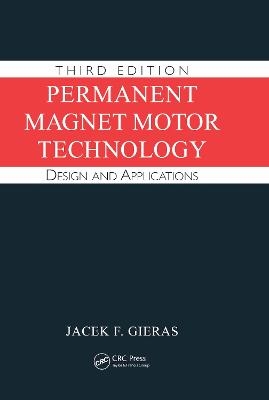
Permanent Magnet Motor Technology
CRC Press (Verlag)
978-1-138-58223-1 (ISBN)
- Keine Verlagsinformationen verfügbar
- Artikel merken
Reflecting innovations in the development of PM motors for electromechanical drives, Permanent Magnet Motor Technology: Design and Applications, Third Edition demonstrates the construction of PM motor drives and supplies ready-to-implement solutions to common roadblocks along the way. This edition supplies fundamental equations and calculations for determining and evaluating system performance, efficiency, reliability, and cost. It explores modern computer-aided design of PM motors, including the finite element approach, and explains how to select PM motors to meet the specific requirements of electrical drives. The numerous examples, models, and diagrams provided in each chapter facilitate a lucid understanding of motor operations and characteristics.
This 3rd edition of a bestselling reference has been thoroughly revised to include:
Chapters on high speed motors and micromotors
Advances in permanent magnet motor technology
Additional numerical examples and illustrations
An increased effort to bridge the gap between theory and industrial applications
Modified research results
The growing global trend toward energy conservation makes it quite possible that the era of the PM brushless motor drive is just around the corner. This reference book will give engineers, researchers, and graduate-level students the comprehensive understanding required to develop the breakthroughs that will push this exciting technology to the forefront.
Professor Jacek F. Gieras, IEEE Fellow
Preface
1. Introduction
1.1 Permanent magnet versus electromagnetic excitation
1.2 Permanent magnet motor drives
1.3 Towards increasing the motor efficiency
1.4 Classification of permanent magnet electric motors
1.5 Trends in permanent magnet motors and drives industry
1.6 Applications of permanent magnet motors
1.7 Mechatronics
1.8 Fundamentals of mechanics of machines
1.9 Torque balance equation
1.10 Evaluation of cost of a PM motor
2. Permanent Magnet Materials and Circuits
2.1 Demagnetization curve and magnetic parameters
2.2 Early history of permanent magnets
2.3 Properties of permanent magnets
2.4 Approximation of demagnetization curve and recoil line
2.5 Operating diagram
2.6 Permeances for main and leakage fluxes
2.7 Calculation of magnetic circuits with permanent magnets
2.8 Mallinson-Halbach array and Halbach cylinder
3. Finite Element Analysis
3.1. Gradient, divergence and curl
3.2 Biot-Savart, Faraday's, and Gauss's laws
3.3 Gauss's theorem
3.4 Stokes' theorem
3.5 Maxwell's equations
3.6 Magnetic vector potential
3.7 Energy functionals
3.8 Finite element formulation
3.9 Boundary conditions
3.10 Mesh generation
3.11 Forces and torques in electromagnetic field
3.12 Inductances
3.13 Interactive FEM programs
4. Permanent Magnet d.c. Commutator Motors
4.1 Construction
4.2 Fundamental equations
4.3 Sizing procedure
4.4 Armature reaction
4.5 Commutation
4.6 Starting
4.7 Speed control
4.8 Servo motors
4.9 Magnetic circuit
4.10 Applications
5. Permanent Magnet Synchronous Motors
5.1 Construction
5.2 Fundamental relationships
5.3 Phasor diagram
5.4 Characteristics
5.5 Starting
5.6 Reactances
5.7 Rotor configurations
5.8 Comparison between synchronous and induction motors
5.9 Sizing procedure and main dimensions
5.10 Performance calculation
5.11 Dynamic model of a PM motor
5.12 Noise and vibration of electromagnetic origin
5.13 Applications
6. d.c. Brushless Motors
6.1 Fundamental equations
6.2 Commutation of PM brushless motors
6.3 EMF and torque of PM brushless motors
6.4 Torque-speed characteristics
6.5 Winding losses
6.6 Torque ripple
6.7 Rotor position sensing of d.c. brushless motors
6.8 Sensorless motors
6.9 Motion Control of PM brushless motors
6.10 Universal brushless motor electromechanical drives
6.11 Smart motors
6.12 Applications
7. Axial Flux Motors
7.1 Force and torque
7.2 Performance
7.3 Double-sided motor with internal PM disk rotor
7.4 Double-sided motor with one stator
7.5 Single-sided motors
7.6 Ironless double-sided motors
7.7 Multidisk motors
7.8 Applications
8. High Power Density Brushless Motors
8.1 Design considerations
8.2 Requirements
8.3 Multiphase motors
8.4 Fault-tolerant PM brushless machines
8.5 Surface PM versus salient-pole rotor
8.6 Electromagnetic effects
8.7 Cooling
8.8 Construction of motors with cylindrical rotors
8.9 Construction of motors with disk rotors
8.10 Transverse flux motors
8.11 Applications
9. High Speed Motors
9.1 Why high speed motors?
9.2 Mechanical requirements
9.3 Construction of high speed PM brushless motors
9.4 Design of high speed PM brushless motors
9.5 Ultra high speed motors
9.6 Applications
10. Brushless Motors of Special Construction
10.1 Single-phase motors
10.2 Actuators for automotive
10.3 Integrated starter-generator
10.4 Large diameter motors
10.5 Three-axis torque motor
10.6 Slotless motors
10.7 Tip driven fan motors
11. Stepping Motors
11.1 Features of stepping motors
11.2 Fundamental equations
11.3 PM stepping motors
11.4 Reluctance stepping motors
11.5 Hybrid stepping motors
11.6 Motion control of stepping motors
11.7 PM stepping motors with rotor position transducers
11.8 Single-phase stepping motors
11.9 Voltage Equations and Electromagnetic Torque
11.10 Characteristics
11.11 Applications
12. Micromotors
12.1 What is a micromotor?
12.2 Permanent magnet brushless micromotors
12.3 Applications
13. Optimization
13.1 Mathematical formulation of optimization problem
13.2 Nonlinear programming methods
13.3 Population-based incremental learning
13.4 Response surface methodology
13.5 Modern approach to optimization of PM motors
14. Maintenance
14.1 Basic requirements to electric motors
14.2 Reliability
14.3 Failures of electric motors
14.4 Calculation of reliability of small PM brushless motors
14.5 Vibration and noise
14.6 Condition monitoring
14.7 Protection
14.8 Electromagnetic and radio frequency interference
14.9 Lubrication
Appendices
A. Leakage Inductance of a.c. Stator Windings
B. Losses in a.c. Motors
Symbols and Abbreviations
References
Index
| Erscheint lt. Verlag | 31.12.2023 |
|---|---|
| Reihe/Serie | Electrical and Computer Engineering |
| Zusatzinfo | 54 Tables, black and white; 328 Illustrations, black and white |
| Verlagsort | London |
| Sprache | englisch |
| Maße | 152 x 229 mm |
| Themenwelt | Technik ► Elektrotechnik / Energietechnik |
| ISBN-10 | 1-138-58223-9 / 1138582239 |
| ISBN-13 | 978-1-138-58223-1 / 9781138582231 |
| Zustand | Neuware |
| Haben Sie eine Frage zum Produkt? |
aus dem Bereich


